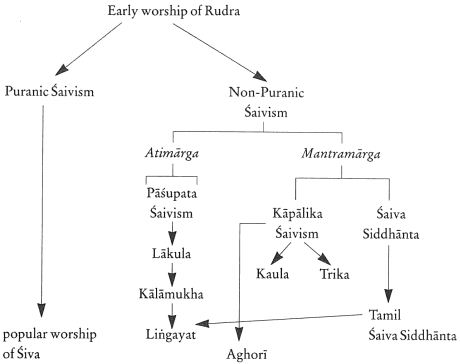Shaivism
 For Shivaism (Sans. Śaiva) are in india a series of movements in which Shiva is looked at as the highest godess. The origins of Shaivism can be traced back to the second century at least.
For Shivaism (Sans. Śaiva) are in india a series of movements in which Shiva is looked at as the highest godess. The origins of Shaivism can be traced back to the second century at least.
Shiva is seen as simultaneously immanent and transcendent.
At first, however, the wild destructive Rudra of the Vedas was revered, and the transition to Shiva happened only gradual.
The later kashmirian worldview of Abhinavagupta goes however far beyond (Paramshiva).
In Shaivism the four cosmic Mahashaktis are aspects of Ishvara. In Siddhanta Sadashiva (and of course a master of the 5th major initiation) exceeds this treshold to Parabrahman. Sadashiva has here 5 faces, of which the Trimurti are three. Above him is the primordial Shiva with his Shakti, which Tarotcard 22 shows. Kashmir shaivism goes still higher up to Paramshiva. This is also the universal sight of the much higher masters.
* Shivaism produced a series of schools in its history of development.
The puranic Shivaism is based on scriptures like the Shiva Purana, Vayupurana, Lingapurana, Skandapurana, Agnipurana, Matsyapurana und Kurmapurana.
Non puranic Shivaism
In addition arose several schools of non-puritan Shivaism, which have nowadays are extinguished, which split into the branches of the
- Atimarga (higher path), whose followers believed that their path leads directly to liberation (sadyo mukti) without intermediate states in higher planes
- The Atimarga was originally a path for ascetics and usually led to a life as a hermit. Here the Pashupata Shivaism (before the Shaiva Siddhanta), the Lakulishas, the Kalamukhas and the Lingayatismus or Vira - Shivaism originate.
and the
- Mantra-marga (path of the mantras) : Niśvāsa ('exhale ', Mūlasūtra), then Siddhantikas, Shaivas, Kapalikas. Here, a gradual path (krama mukti) is taught to liberation.
In the Shaiva Siddhanta Shiva is regarded as a personal deity and moksha looked at as a fusion with the personal god. The writings used are the Meykanda-Sastra, the Tirumurai anthems, the Thirukkural, the Vedas and the extensive Saiva-Agamas
In parallel arose :
- The Kashmiri Shivaism, enhanced by Abhinavagupta (Paramshiva)
- the Aghoris of the Vama-achara.
- the Natha-Yogis (Gorakhnath, asketic shaivists, Hatha Yoga, Alchemy; The body below the navel is regarded as Shakti and above the navel as Shiva
- Shiva Advaita (Srikantha, ca. 1050, also named Shiva Vishishtadvaita)
- Dashanami Sampradaya, which was founded in the 8th century by Adi Shankara. It is often also counted among the Shaivas, and some subgroups are unambiguously shivaist with a primarily monistic wordview similar to Kashmir Shivaism
The main writing of the Juna Akhada, who rely on Sadashiva and Shri Shankaracharya, the Avadhut Gita (song of an enlightened man), is a radical monistic work and can be regarded as continuation of the Advaita-Vedanta.
It was revealed by a deity Dattatreya, represented as the embodiment of the Trimurti.
The Ganapataya sect, however, was a shift from Shiva to Ganesha.
Shaiva Texts
Literature
- Tantra in Practice (Princeton Readings in Religions), David Gordon White, Motilal Banarsidass, 2001
- Tantra and Shri Vidya PDF
- Christopher Tompkins : Introduction into tantric shaivism
- Siva nana bodham (Handbook of shaivism)
- Agamas - The Sacred Texts Of Saivism
- Encyclopaedia of the Śaivism, Band 1, Swami Parmeshwaranand , ISBN-10: 8176254274 / ISBN-13: 978-8176254274 (Archive)
- Saiva texts
- Saiva literature jist kyoto
- The Role of Religious Experience in the Traditions of Tantric Shaivism, Christopher Daren Wallis, diss.
References
- http://shivadarshana.blogspot.de/2007/12/worship-of-shiva-shakti-is-exceedingly.html Atimarga
- http://www.hindupedia.com/en/Mantra_Marga Mantra Marga
- http://www.shaivam.org/siddhanta/thiru.html
- https://de.wikipedia.org/wiki/Shivaismus#Natha-Yogis
- http://www.hinduismtoday.com/modules/smartsection/item.php?itemid=3249 Siva Advaita
- http://rampuri.com/about/juna-akhara/ juna-akhara
Weblinks
- Wiki on Shaivism
- Puranic shaivism
- Oiktv :Shaivism
- Shivaismus and Kali-Yuga
- Saiva Vidyas
of Spirituality
universal-path.org